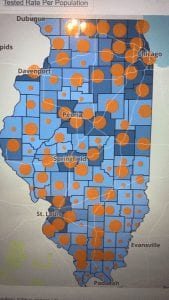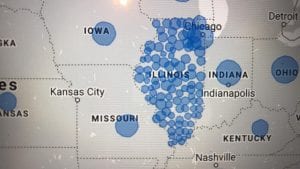It’s Not Over Yet: Illinois Surges Past One-Million Cases Of Covid-19
It was 350 days ago when Illinois announced its first case of covid-19.
Today, the state went over one million in cases, meaning almost one in 12 people in the state have tested positive for the virus, according to statistics from the Illinois Department of Health.

Illinois, including both sides of the Quad-Cities, remains a covid-19 hot spot.
As of Thursday night, 3,777 patients in Illinois were reported to be in the hospital with COVID-19. Of those, 780 patients were in the ICU and 422 patients with COVID-19 were on ventilators, according to statistics from the Illinois Department of Health.
Illinois health officials reported 9,277 new COVID-19 cases and 126 deaths Friday.
The total number of cases in Illinois now stands at 1,017,322, with a total of 17,395 deaths, since the start of the COVID-19 pandemic.
“In a pandemic that has contained far too many tragic milestones, today’s marking of one million cases of COVID-19 diagnosed in Illinois deserves particular recognition,” Gov. JB Pritzker said during his online press conference about the virus. “As this disease continues to wreak havoc on our nation – with the United States setting another record for the most COVID-19 deaths in a day just yesterday – it is critical that we take extra caution today and in the months ahead to reduce the spread, bring down hospitalization rates, and save lives. Now that vaccine distribution has begun, we can see the light at the end of this difficult time – let’s do everything we can to ensure all of our neighbors are able to be there as we cross that finish line, healthy as well. With that goal in mind, I encourage all Illinoisans to choose to receive the protections of the COVID-19 vaccine when it’s your turn in line.”
“As the vaccine rolls out, our hope, and goal, is that the number of new cases we see each day will decrease,” said IDPH Director Dr. Ngozi Ezike. “Reporting more than one million COVID-19 cases in Illinois seemed like an unlikely number at the

Illinois covid cases exploded in the fall, causing governor JB Pritzker to enact mitigations on Nov. 20.
beginning of the pandemic, and we’ve now all seen how devastating this disease can be. I urge everyone to continue to wear their mask, avoid social gatherings, and get vaccinated when it’s your turn.”
Still, Pritzker said, due to Tier 3 mitigations put in place on Nov. 3, the numbers have been blunted, and some regions in the state could see an easing of those restrictions next week.
“On Jan. 15, exactly one incubation period from New Year’s Day, any region that has met the metrics for a reduction of mitigations will be able to move out of Tier Three of our mitigation plan,” Pritzker said.

JB Pritzker during his press conference.
Illinois has been in Tier 3 mitigations since Nov. 20. The restrictions shut down indoor dining and other indoor recreation venues like theaters, casinos and live performance venues, suspended indoor dining entirely, and lowered capacity for outdoor dining and other activities.
According to the metrics put forth by Pritzker on Nov. 20, a region can move down to phase 4 mitigations if it sees a test positivity rate less than 12% for three consecutive days and more than 20% of ICU and hospital beds are available, as well as declining COVID-19 hospitalizations in seven of the previous 10 days. A number of Illinois regions are near or below those numbers.
Pritzker touted the mitigations as helping the state avoid even more catastrophic numbers, saying Illinois “did not experience the post-Thanksgiving uptick that plagued much of the country,” and that the mitigations and their duration has put the state on the course to open up more safely.
“Since Nov. 30, I have maintained – at the advice of Dr. [Anthony] Fauci, the [Illinois Department of Public Health] and other infectious
disease experts – that it would be unwise to downgrade any region from our current Tier Three mitigations while in the holiday season, when people were particularly prone to gather in multi-family groups and do it without masks – the things that could deliver the worrisome ‘surge upon a surge,'” Pritzker said during an online press conference. “I’m cautiously optimistic as there are some early signs indicating that some regions have made real progress and won’t reverse that progress this week or next.”













Leave a Reply
You must be logged in to post a comment.